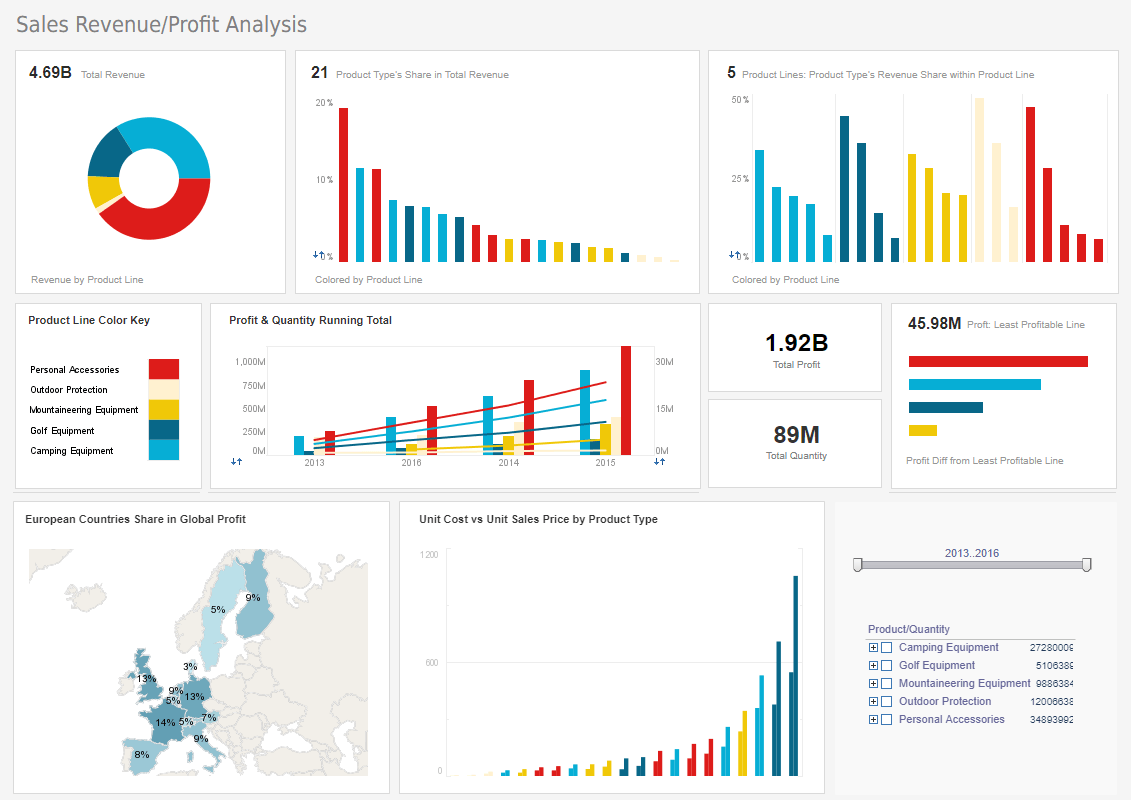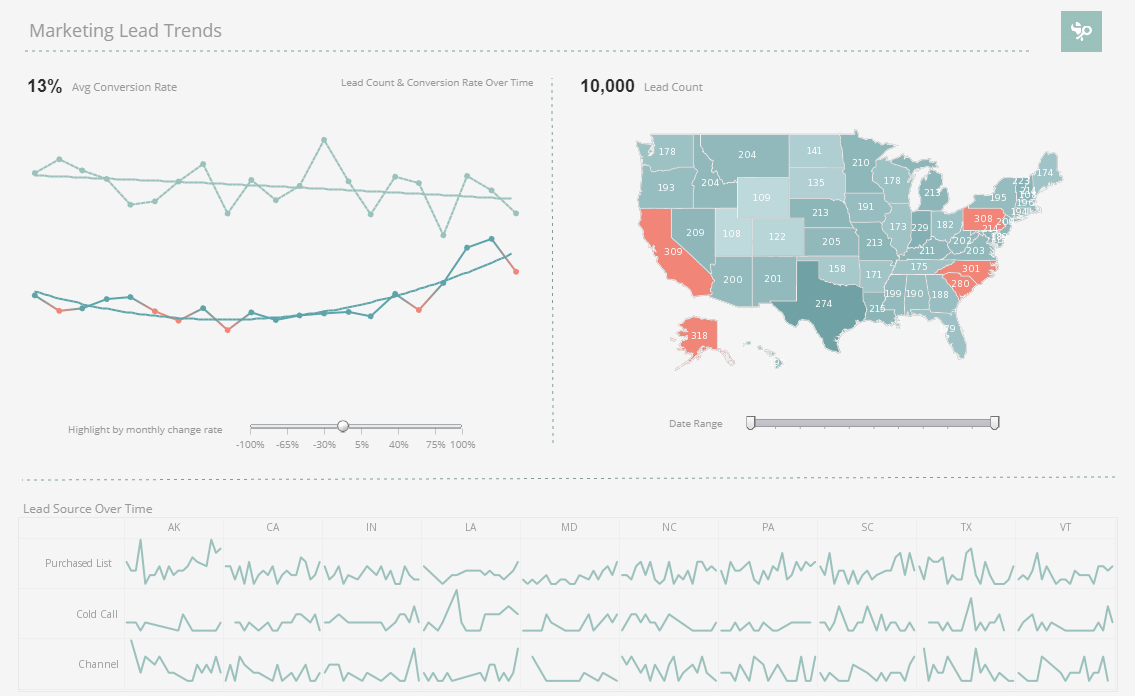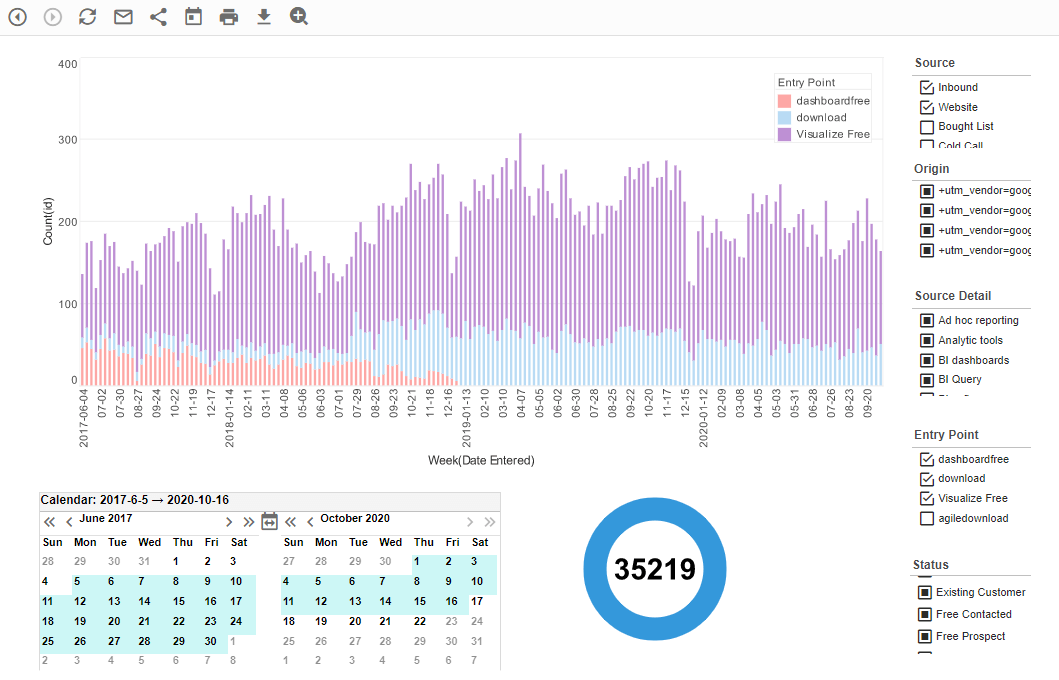Advantages of InetSoft's Dashboard Server Software
Are you researching dashboard server options for your company? InetSoft's solution has been deployed by over 5,000 customers worldwide and is highly rated for easy installation and responsive support.
Get cloud-flexibility for your deployment. Minimize costs with a small-footprint solution. Maximize self-service for all types of users. No dedicated BI developer required. View a demo and try interactive examples.



Advantages
StyleBI is InetSoft's server-based enterprise dashboard visualization tool. With that distinction comes many advantages:
• No need to connect directly to the data. Style intelligence allows users to connect remotely.• Not limited to developing a single view of the data to be published. StyleBI provides automatic data security, showing appropriate data based on the user.
• Don't have to use either a single dataset or have pull multiple sources together using script. Style intelligence provides end-user data mashup, allowing users to combine many data sources through a simple drag-and-drop interface.
• Not targeted narrowly at analysts who have advanced enough skills to handle the configuration and scripting necessary to build a dashboard.
Benefits
StyleBI, InetSoft's dashboard product:
• Allows users to connect to data sources remotely.• Provides automatic data security, showing appropriate data based on the user.
• Provides end-user data mashup, allowing users to combine many data sources through a simple drag-and-drop interface.
• Is accessible by a broad range of users due to its user interface and data mashup engine.
Using StyleBI Serverless Dashboard Microservice for Real-Time Crisis Management
In the fast-paced world of IT, where milliseconds can mean the difference between containment and catastrophe, real-time crisis management is a critical capability. InetSoft’s Style Intelligence (StyleBI) serverless dashboard microservice offers a powerful solution for IT professionals tasked with monitoring and responding to crises, such as system outages, cybersecurity breaches, or natural disasters impacting infrastructure. By leveraging a serverless architecture, StyleBI provides scalable, low-latency dashboards that empower IT teams to visualize, analyze, and act on data in real time, ensuring rapid response and effective decision-making. This article explores how StyleBI’s serverless dashboard microservice can be utilized for real-time crisis management, detailing its architecture, key features, and practical applications for an IT audience.
Understanding StyleBI’s Serverless Architecture
StyleBI’s serverless dashboard microservice is built on a modern, cloud-native framework that eliminates the need for managing underlying server infrastructure. Unlike traditional BI platforms that require dedicated servers and complex maintenance, StyleBI’s serverless approach leverages cloud providers like AWS Lambda or Azure Functions to dynamically scale resources based on demand. This ensures that dashboards remain responsive even during high-traffic scenarios, such as a sudden spike in monitoring needs during a crisis. For IT professionals, this means reduced overhead in server provisioning and maintenance, allowing focus on data analysis and response rather than infrastructure management.
The microservice architecture further enhances flexibility by breaking down dashboard functionalities into lightweight, independent components. Each microservice handles specific tasks—data ingestion, visualization rendering, or alert generation—enabling seamless integration with existing IT ecosystems. This modular design ensures that IT teams can customize dashboards to pull data from diverse sources, such as network monitoring tools, security information and event management (SIEM) systems, or IoT sensors, making StyleBI ideal for dynamic crisis scenarios.
Key Features for Crisis Management
StyleBI’s serverless dashboard microservice offers several features tailored for real-time crisis management, making it a standout choice for IT teams:
- Real-Time Data Streaming: StyleBI supports real-time data ingestion from APIs, databases, and streaming platforms, ensuring dashboards reflect the latest system states. This is critical for monitoring live metrics like server uptime, network latency, or intrusion detection alerts during a crisis.
- Interactive Visualizations: The platform provides dynamic charts, heatmaps, and gauges that allow IT teams to drill down into specific data points. For example, during a DDoS attack, teams can visualize traffic spikes and pinpoint affected servers instantly.
- Automated Alerts and Notifications: StyleBI enables threshold-based alerts that notify teams via email, SMS, or integrated platforms like Slack when anomalies are detected, such as a sudden drop in system performance.
- Role-Based Access Control: IT teams can assign specific dashboard views to different roles—sysadmins, security analysts, or executives—ensuring relevant data is accessible without overwhelming users with irrelevant details.
- Scalability and Low Latency: The serverless backend automatically scales to handle increased data loads, ensuring dashboards remain responsive even under intense crisis conditions.
These features collectively enable IT teams to maintain situational awareness and respond proactively, minimizing downtime and mitigating risks.
Scenario: Managing a Cybersecurity Breach
Consider a scenario where an IT team at a financial institution detects a potential cybersecurity breach, such as a ransomware attack targeting critical servers. StyleBI’s serverless dashboard microservice can be deployed to manage this crisis effectively. Here’s how:
First, the IT team configures StyleBI to integrate with their SIEM system, pulling real-time data on network traffic, login attempts, and file access logs. The microservice’s data ingestion layer connects to the SIEM’s API, streaming alerts and metrics into a centralized dashboard. Within minutes, a live dashboard is created, displaying key indicators like failed login attempts, unusual data transfers, and affected endpoints.
The dashboard’s interactive visualizations allow security analysts to drill down into suspicious activities. For instance, a heatmap might reveal a cluster of unauthorized access attempts from a specific IP address, enabling the team to block it immediately. Meanwhile, automated alerts notify the incident response team when predefined thresholds—such as a spike in encrypted file modifications—are exceeded, ensuring rapid escalation.
StyleBI’s role-based access ensures that executives receive a high-level overview of the breach’s impact, such as affected systems and estimated downtime, while technical teams access detailed logs and metrics. The serverless architecture handles the surge in data processing without latency, even as the attack generates thousands of alerts per minute. By centralizing and visualizing this data, StyleBI enables the IT team to contain the breach, isolate compromised systems, and initiate recovery protocols within hours, minimizing financial and reputational damage.
Benefits for IT Teams
Using StyleBI’s serverless dashboard microservice in crisis management offers several advantages for IT teams:
- Rapid Deployment: The drag-and-drop interface and pre-built connectors allow dashboards to be set up in minutes, critical for time-sensitive crises.
- Cost Efficiency: The serverless model eliminates the need for over-provisioned servers, reducing costs during low-demand periods while scaling seamlessly during crises.
- Flexibility: Integration with diverse data sources, from cloud services to on-premises databases, ensures StyleBI adapts to any IT environment.
- Collaboration: Annotations and shared dashboards enable IT teams to collaborate in real time, discussing insights and coordinating responses directly within the platform.
These benefits translate into faster resolution times and improved resilience, key priorities for IT departments managing critical infrastructure.
Technical Implementation Considerations
Implementing StyleBI for crisis management requires careful planning to maximize its effectiveness. IT teams should start by identifying key data sources relevant to their crisis scenarios, such as monitoring tools (e.g., Prometheus, Nagios), cloud platforms (e.g., AWS CloudWatch), or external feeds (e.g., threat intelligence APIs). StyleBI’s Data Block technology simplifies data mashups, allowing teams to combine these sources into a unified dashboard without complex ETL processes.
Next, teams should define alert thresholds and notification workflows. For example, in a server outage scenario, alerts could trigger when CPU usage exceeds 90% for more than five minutes, notifying on-call engineers via Slack. IT administrators should also configure role-based access to ensure sensitive data, like security logs, is restricted to authorized personnel.
Finally, teams should leverage StyleBI’s serverless scalability to handle peak loads. During testing, IT departments can simulate crisis scenarios, such as a simulated DDoS attack, to ensure the dashboard performs under stress. The serverless backend automatically allocates resources, ensuring low-latency performance even when processing millions of data points.
Challenges and Mitigation Strategies
While StyleBI is powerful, IT teams may face challenges in adoption. Data integration can be complex if sources use proprietary formats, requiring custom API connectors. To mitigate this, teams should leverage StyleBI’s extensive library of pre-built connectors or work with InetSoft’s support team to develop custom integrations.
Another challenge is ensuring data accuracy during high-velocity crises, as incomplete or inconsistent data can lead to poor decisions. IT teams should implement data validation checks within StyleBI to filter out anomalies before they reach the dashboard. Finally, user training is essential to maximize the platform’s potential. While StyleBI’s interface is intuitive, regular training sessions can help non-technical stakeholders, like executives, effectively interpret dashboards.
